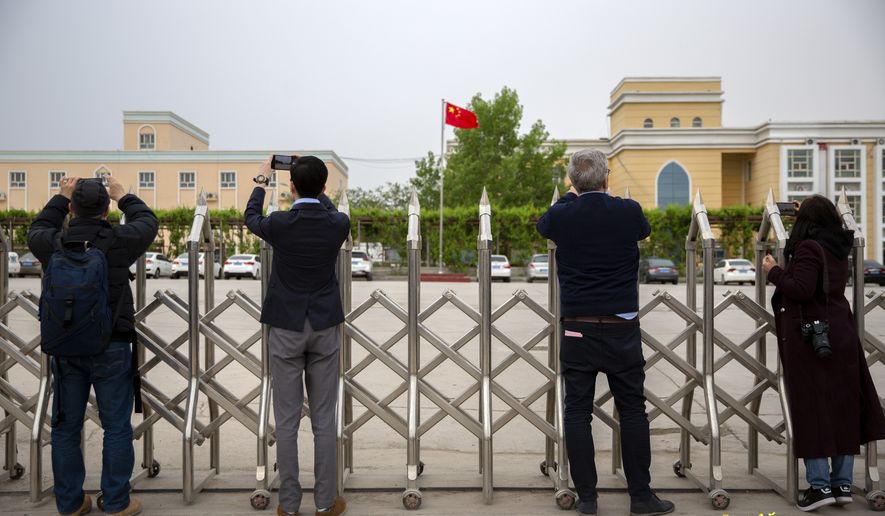Tibetans are experiencing mass repression in China similar to that being enforced on ethnic minority Uyghurs in the western part of the country, the outgoing president of the Tibetan government in exile said.
Lobsang Sangay, head of the exile government loyal to Tibetan Buddhist spiritual leader the Dalai Lama, said China is forcibly trying to turn Tibet into a Chinese province and Tibetans into Chinese, even as Tibet’s cause is getting less attention in the Western press.
“We should always remember that Tibet is Patient Zero when it comes to ‘minorities’ in China,” Mr. Sangay said in an interview with The Washington Times.
Tibet was an independent state in the Himalayas until Chinese troops annexed the region in 1950. The Dalai Lama fled into exile in India, where the exile government is based to this day.
Critics say China’s communist government for decades has been engaged in a systematic campaign that seeks to forcibly assimilate Tibetans into Han Chinese culture and remove all vestiges of Tibetan religion and culture, Mr. Sangay said.
Many of the same methods first used in Tibet are now sparking international condemnation in Xinjiang, where as many as 1 million Uyghurs have been placed in internment camps. Both the Trump and Biden administrations have labeled China’s policies toward the Uyghurs as a “genocide.”
“It’s not exactly the same, but it is similar,” Mr. Sangay said. “Labor camps are set up in Tibet.”
Mr. Sangay said 500,000 Tibetan youths have been taken from their families in remote areas by the Chinese government and moved to urban centers, where they are forced to undergo military-style training. The Chinese government justified the abuse by claiming Tibetans are lazy and need to be strengthened and given skills and training.
“For the Chinese government, it is ‘poverty alleviation.’ But for us, it is cultural assimilation: Make Tibet into a Chinese province and Tibetans into Chinese.”
Chinese authorities in Tibet are given quotas for the number of young people forced to undergo the training, he said.
The Beijing strategy for controlling Tibet, which overseas Tibetans consider an occupied nation, was outlined by the ruling Chinese Communist Party in the early 2000s in what is called Document No. 5. The document requires all Buddhist lamas to register with the state and not to practice their religion until given party approval to do so.
“Can you imagine an atheist organization issuing a certificate for a spiritual authority?” Mr. Sangay said.
Mr. Sangay also said the Chinese government is continuing to hide the senior spiritual leader known to Tibetan Buddhists as the 11th Panchen Lama. Gedhun Choekyi Nyima was recognized at age 6 by the Dalai Lama in May 1995 and three days later was taken into custody by the Chinese government.
Mr. Sangay said the U.S. government has asked Beijing about the fate and location of the Panchen Lama, but China has continued to stonewall the government and the Tibetan government in exile, representing some 150,000 overseas Tibetans.
State Department spokesman Ned Price last week made an explicit appeal for U.S. access to the Panchen Lama, noting that the Tibetan spiritual heir was marking his 32nd birthday this month and was being “forced to spend another year disappeared, separated from his community, and denied his rightful place as a prominent Tibetan Buddhist leader.”
“We call on the PRC Government to immediately make public the Tibetan-venerated Panchen Lama’s whereabouts and to give us this opportunity to meet with the Panchen Lama in person,” Mr. Price told a briefing April 22. “We respect Tibetans’ right to select, educate and venerate their own leaders, like the Dalai Lama and the Panchen Lama, according to their own beliefs, and without government interference.”
The Chinese government appointed its own rival Panchen Lama in preparing for the eventual passing of the Dalai Lama, now 81.
The appointment is an attempt by the Chinese government to say that “loyalty to the Communist Party is more important than spiritual belief,” Mr. Sangay said.
The former party secretary in Tibet, Chen Quanguo, is now China’s leading party official in Xinjiang.
Mr. Chen was sanctioned by the Treasury Department in July for his suspected role in human rights violations in Xinjiang. U.S. officials described him at the time as having a “notorious history of intensifying security operations in the Tibetan Autonomous Region to tighten control over the Tibetan ethnic minorities.”
The State Department’s most recent report on human rights states said China’s government is engaged in human rights abuses in Tibet, including torture and cases of cruel, inhuman, and degrading treatment or punishment by the government. Arbitrary arrests and detention and taking political prisoners are also common, the U.S. survey said.
Mr. Sangay said the situation of Tibetans inside China is “very painful.”
“Tibetans have been forced to resort to extreme measures to show their sentiment, partly because the Chinese government doesn’t allow any peaceful protests,” Mr. Sangay said.
Those Tibetans that organize and protest opposition to Communist Party rule are arrested, tortured and often die in prison, he said.
That has led Tibetans to sacrifice their lives in self-immolation.
Mr. Sangay said in the interview that he is nevertheless “pretty content” about his tenure as president of the government in exile. He cited the new U.S. law enacted in December officially stating U.S. policy that succession of Tibet’s leaders, including the Dalai Lama, must be left solely to Tibetan Buddhists without interference from the Chinese government. The law also calls for setting up a U.S. consulate in Lhasa, capital of the Tibet Autonomous Region.
Mr. Sangay called the law “a huge deal” that energized the Tibetan independence movement.
—
Corrected from an earlier version which incorrectly described the Panchen Lama as the successor to the Dalai Lama.
• Bill Gertz can be reached at bgertz@washingtontimes.com.




Please read our comment policy before commenting.